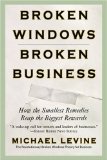 Broken Windows, Broken Business: How the Smallest Remedies Reap the Biggest Rewards
Broken Windows, Broken Business: How the Smallest Remedies Reap the Biggest Rewards
by Michael Levine
This is one of those books promoting a theory that appears to be extremely obvious, easy to support, and somewhat difficult to argue with. Common sense, if you will. Or maybe uncommon sense better describes this theory. I say that because we see resounding evidence every day in every industry across the country that would suggest that a large number of organizations either don’t believe or choose not to practice this philosophy.
The theory itself was first published in 1982 but is probably more relevant 26 years later than ever before. The message is very clear and, indeed, simplistic. The author’s premise is one that we have espoused many times as a result of our research, consulting and training experience. Sweat the small stuff!
Levine’s premise suggests that what you pay attention to determines what you miss as well. If you only “focus” on the major issues in your business, you neglect the minor issues, and the neglect of the “small stuff” is a path to organizational demise.
Essentially, Levine is “challenging” the 80/20 MBA B.S., and invoking a new mantra, which probably should be called the “100/0” rule … EVERYTHING MATTERS!
In all honesty, every organization has “broken windows” in one form or another. They are inevitable. Think about those you yourself have witnessed in a typical day.
- Litter on the grounds.
- Improper or impolite telephone procedure.
- Confusing web site.
- Dead plants in the lobby.
- Filthy rest rooms.
- Dimly lit rooms.
- Poor signage.
- Peeling paint.
- Long lines.
- Poorly maintained restrooms.
- Incompetent personnel.
- Lack of follow through.
- Poor communication skills.
- Poor employee appearance.
- Dirty windows.
- Worn carpets.
Levine’s key point is that organizations whose culture demands perfection in all operations and cordiality in all relationships will (a) minimize the number of their “broken windows” and (b) immediately repair those few which occur.
Too many managers are trained, like dogs, to robotically look at spreadsheets, improve metrics, and number crunch regularly. Of course, numbers do matter.
Levine’s emphasis is to get beyond just the numbers, open your eyes, and LOOK, really NOTICE the details, because it doesn’t matter what your current numbers show, if you are missing the big picture which is CUSTOMER PERCEPTION!
There is compelling evidence that problems in business, large and small, typically stem from inattention to tiny details! And you can be certain that customers spot those details every time!
In March 1982, criminologists James Q. Wilson and George L. Kelling introduced the “broken windows” theory. Social psychologists and criminologists who agreed that if a window in a building is broken and left unrepaired, soon thereafter the rest of the windows will be broken—and the perception will build that crime in that neighborhood is out of control. The same principle applies to business. Constant attention to detail not only demonstrates corporate competence, but also shows that the company cares about what the consumer wants. A company’s metaphorical “broken windows,” whatever they may be, send the opposite signal: that the business doesn’t care and this obviously repels customers!
So what does the author recommend to remedy this very serious situation? His advice is fairly routine:
- Deploy mystery shoppers to ferret out shortcomings.
- Remember that first impressions are lasting.
- Strive to “exceed expectations.”
- Request, respond to and appreciate customer feedback.
- Cultivate “the obsessive, compulsive, almost violent need to find the flaws.”
- Refuse to tolerate employees who don’t smile or are otherwise “coasting, doing their time, merely existing” and infecting other workers with their “virus.”
- Communicate clearly the Broken Window theory to your staff along with your expectations of them and the role they play in this philosophy.
- Seek out and immediately repair every “broken window” throughout your organization.
Almost everything Levine recommends should require little (if any) expenditure of hours or dollars.
I read of a man and wife who would patronize only one local car wash. The pricing was competitive. What differentiated it from its competition? Those who work there were friendly, the interior and exterior waiting areas were always impeccably clean as well as well-lit, and most important of all, every car was always thoroughly cleaned inside and out. One final point, just before the attendant waved his or her towel, the side windows were rolled down an inch or two so that no water line is left. An insignificant detail? Not to this couple and obviously many others. No broken windows here! And the employees played an intricate part of supporting this theory.
Using dozens of corporate “broken window” case studies, including McDonalds, Kmart, Google, JetBlue, and more, the author argues that by integrating the solutions to small problems into a much larger plan, the resulting combined solution can stimulate overall business growth and keep customers coming back for more.
Again this theory is obviously true. It is indeed simple. Experience proves it to be advantageous for everyone involved. Then why don’t we see more organizations practicing this theory? Could there possibly be a knowing-doing gap here? More than likely.
If so, indifference may well be the largest “broken window” in need of repair.
(This book review was originally published in 2008 as one of the Top 10 Books – Edition 17.)
